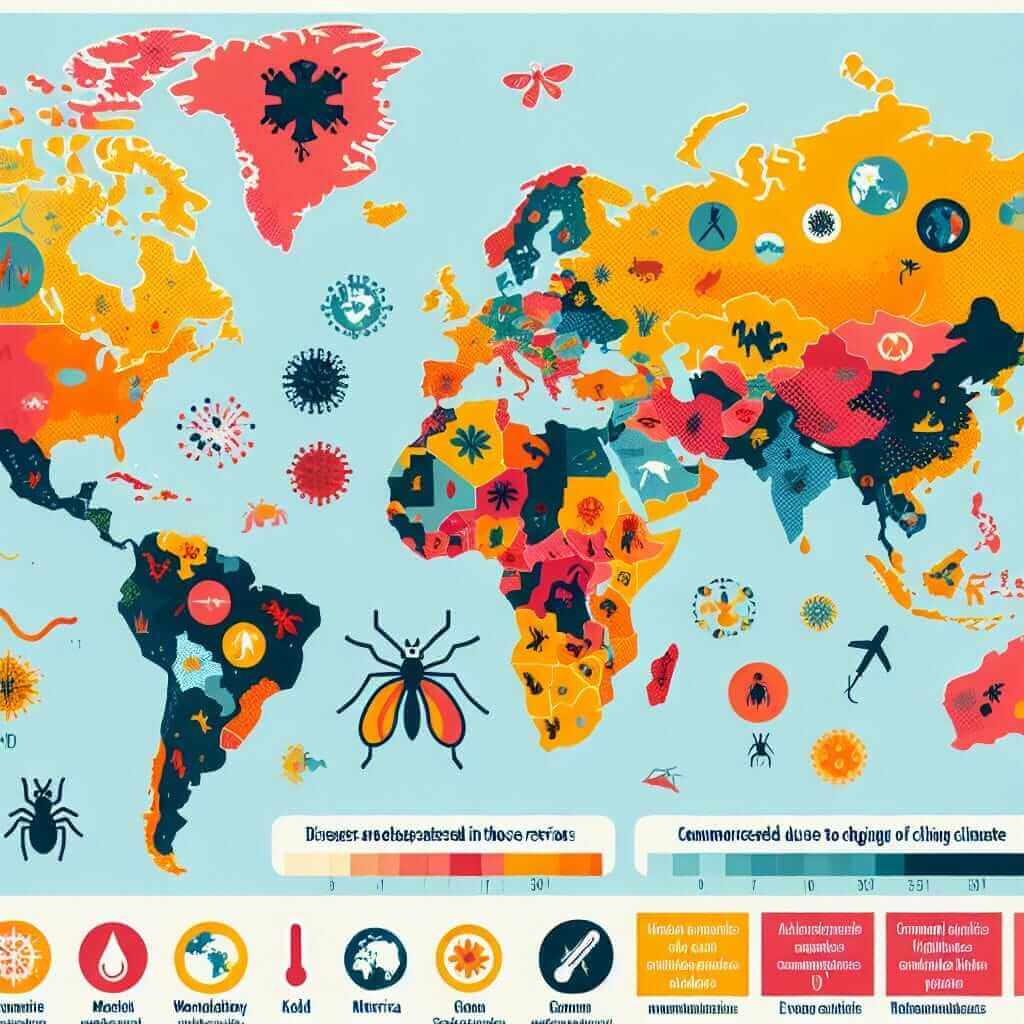The IELTS Reading Test is a critical component of the IELTS exam, designed to evaluate a candidate’s ability to understand and interpret texts sourced from a variety of contexts. Topics related to current global issues, such as climate change and its impact, are highly relevant and often feature in IELTS Reading passages. Given the increasing prevalence of discussions around climate change, understanding its influence on disease spread can prepare you for similar topics in the IELTS exam.
Reading Passage: Climate Change and Disease Spread
Here is a sample reading passage crafted to reflect the style and complexity typical of an actual IELTS Reading exam. This passage tackles the question “How does climate change influence disease spread?”
Climate Change and Disease Spread
Climate change, characterized by global warming and significant changes in weather patterns, has far-reaching consequences on the environment and human health. One of the most pressing concerns is its impact on the spread of diseases, both infectious and non-infectious.
Globally rising temperatures create more hospitable environments for disease vectors such as mosquitoes and ticks. Mosquitoes, carriers of diseases like malaria, dengue, and Zika virus, thrive in warmer climates. Extended periods of warmth and increased humidity levels extend the breeding season of mosquitoes, elevating the risk of outbreaks in previously temperate regions. This geographical shift means that countries unaccustomed to such diseases now face new health challenges.
Moreover, changes in precipitation patterns contribute to the spread of waterborne diseases. Heavy rainfall and flooding can overwhelm sewage systems, leading to contamination of water supplies with pathogens such as cholera and E. coli. Conversely, prolonged droughts can reduce freshwater availability, concentrating pathogens in limited water sources and increasing the likelihood of disease transmission.
Furthermore, climate change impacts agricultural practices, influencing food security and the spread of zoonotic diseases. Livestock, when exposed to new environmental stresses or forced migrations, may encounter pathogens previously unfamiliar, increasing the risk of zoonotic disease transmission to humans. Additionally, agricultural workers and consumers may face increased exposure to pesticide-resistant pests and pathogens, again aggravated by climate change.
Lastly, indirect consequences of climate change such as displacement and migration also heighten disease spread risks. Populations moving from degraded environments might carry diseases to new areas, while crowded refugee camps with inadequate sanitation can become hotspots for disease outbreaks.
In conclusion, climate change has a multifaceted influence on disease spread, affecting vectors, water and food sources, and human migration. Understanding these dynamics is crucial for developing effective public health strategies to mitigate the adverse impacts of climate change.

Questions
Multiple Choice
-
According to the passage, how do rising temperatures affect mosquito populations?
- A. They reduce the mosquito breeding season.
- B. They increase the breeding season and geographical range of mosquitoes.
- C. They decrease the geographical range of mosquitoes.
- D. They have no significant impact on mosquito populations.
-
What effect do prolonged droughts have on disease spread?
- A. They decrease pathogen concentration in water sources.
- B. They make no difference to waterborne diseases.
- C. They increase pathogen concentration in limited water sources.
- D. They increase the availability of clean freshwater.
True/False/Not Given
-
Heavy rainfall typically improves the function of sewage systems.
- True
- False
- Not Given
-
Climate change only affects infectious diseases, not non-infectious diseases.
- True
- False
- Not Given
Matching Information
Match the descriptions (A-D) with the corresponding categories (1-4):
-
Descriptions:
- A. Increased breeding season of disease vectors
- B. Contaminated water sources
- C. Agricultural challenges
- D. Refugee health concerns
-
Categories:
-
- Waterborne diseases
-
- Zoonotic diseases
-
- Vector-borne diseases
-
- Migration effects
-
Short-answer Questions
-
Name one disease carried by mosquitoes that has spread due to climate change.
-
What is one consequence of climate change on livestock?
Answer Keys
Multiple Choice
- B. They increase the breeding season and geographical range of mosquitoes.
- C. They increase pathogen concentration in limited water sources.
True/False/Not Given
- False
- False
Matching Information
- B – Contaminated water sources
- C – Agricultural challenges
- A – Increased breeding season of disease vectors
- D – Refugee health concerns
Short-answer Questions
- Malaria (or dengue, Zika virus)
- Increased risk of zoonotic disease transmission due to exposure to new pathogens or forced migrations.
Common Mistakes
- Skimming Too Quickly: Many students fail to note critical information by skimming too hastily. Ensure you read carefully.
- Incorrect Inferences: Do not assume information not stated in the passage.
- Overlooking Keywords: Pay attention to keywords that link to the questions.
Vocabulary
- Vector (noun, /ˈvɛktər/): An organism, typically a biting insect or tick, that transmits a disease or parasite from one animal or plant to another.
- Zoonotic (adjective, /ˌzuːəˈnɒtɪk/) disease: A disease that can be transmitted from animals to humans.
- Pathogen (noun, /ˈpæθədʒən/): A bacterium, virus, or other microorganism that can cause disease.
Grammar Focus
Complex Sentence Structures
- Relative Clauses: “Populations moving from degraded environments, which might carry diseases to new areas, face…”. Practice using relative clauses to add detailed information without repeating nouns.
- Passive Voice: “Water supplies are contaminated with pathogens during heavy rainfall.” Passive voice can emphasize the action rather than the subject performing it.
Recommendations for IELTS Reading Success
- Practice Regularly: Consistency is key to improving reading skills.
- Use Authentic Materials: Engage with genuine IELTS reading materials and topics of current relevance.
- Enhance Vocabulary: Learn and practice using context-specific vocabulary.
- Simulate Test Conditions: Time yourself during practice to build speed and accuracy.
Good luck with your IELTS preparation! Keep practicing, and you’ll see your scores improve.